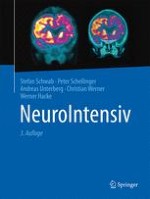Zusammenfassung
In diesem Kapitel werden im Schwerpunkt entzündliche bzw. autoimmune Erkrankungen des neuromuskulären Systems sowie spezifische Erkrankungen behandelt. Zu den ersteren gehören das Guillain-Barré-Syndrom (GBS; Acute Inflammatory Demyelinating Polyneuroradiculitis, AIDP) als häufigste Variante der schweren akuten entzündlichen Polyradikuloneuritiden und die Myasthenia gravis, vorwiegend in der intensivpflichtigen Maximalausprägung. Rhabdomyolyse, malignes neuroleptisches Syndrom, maligne Hyperthermie, und Critical- Illness-Polyneuropathie und -myopathie sind typische Erkrankungen, die eine (neuro)intensivmedizinische Versorgung bedingen. Die Langzeitprognose ist nach überstandener Akutphase sehr gut, obwohl CIP und CIM eine häufige Ursache für eine notwendige Langzeitbeatmung sind. Auch wenn Botulismus und Tetanus eher selten anzutreffen sind, stellen sie wichtige neurointensivmedizinische Erkrankungen dar, die früh erkannt und behandelt werden müssen.











